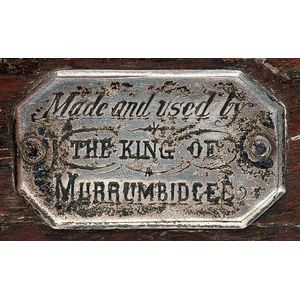King of Murrumbidgee's Fighting Boomerang
A boomerang made and used by the King of Murrumbidgee, Murrumbidgee, New South Wales (mid nineteenth century), carved hardwood and sterling silver, 88 cm long. A fighting boomerang that carries a sterling silver plaque identifying it as having been 'made and used by the King of Murrumbidgee.' Fighting boomerangs are non-returning and were thrown in the air or along the ground to cartwheel towards an opponent. Those from the Murrumbidgee or southern New South Wales region tend to be undecorated and large, up to about 90 cm in length (Jones, P., boomerang: Behind an Australian icon, Wakefield Press, Adelaide, 1996, p. 98). The literature reveals few clues as to the identity of the 'King of Murrumbidgee' although the evidence is inconclusive. In Aborigines of the Canberra Region, L.L. Gillespie, Canberra, 1984, Lyall Gillespie makes reference a young Aboriginal man called Wellington 'who was said to be the king of the Murrumbidgee blacks and frequented the Yarralumla area' (Gillespie 1984:21). Yarralumla, now an inner suburb of Canberra, was in the 1840s the home of (Sir) Terence Aubrey Murray (1810-1873), who was to become a member of the Legislative Assembly of New South Wales. In 1844, George Augustus Robinson (1791-1866), the Chief Protector of Aborigines in New South Wales, including the Port Phillip area (Victoria), visited Yarralumla on his journey to south-east Australia. Robinson made a list of forty-eight Aboriginal people he met at or near Yarralumla: a journal entry of 12 September 1844 reads 'Saw a number of Limestone Blacks at Mr Murray's, Mr Murray invited me to stay, took names:' (Clarke, I.D. [ed], The Journals of George Augustus Robinson, Chief Protector, Port Phillip Aboriginal Protectorate, Volume Four: 1 January 1844 - 24 October 1845, Heritage Matters, Melbourne, 1998, pp. 203-4). The name Wellington (Moridjergang) appears on the list and is referred to by Robinson as his 'interpreter' who 'communicated' (Robinson in Clark 1998:270) to him a vocabulary of local Aboriginal words. Moridjergang was sixteen years of age at the time, and not a member of the Limestone Plains people (Gillespie 1984:31, 59). In later articles, Moridjergang has been described as being a good stockman (W Davis Wright, Canberra, John Andrew & Co., Sydney, 1923) and as 'a king, very tall [who] wore a breastplate' (K. McP., 'Reminiscences of Old Canberra', in the Sydney Morning Herald of 14 January 1922, p. 16). Compare this boomerang to a similar one collected by the naturalist Charles Daley (1859-1947) from south-central New South Wales in the 1890s, now in the collection of the South Australian Museum, which Philip Jones terms 'an intermediate type between the heavy boomerangs of the Eyre Basin and the lighter, more angular boomerangs of south-eastern Australia' (Jones 1996:100). Wally Caruana. Provenance: Private Collection, United Kingdom
You must be a subscriber, and be logged in to view price and dealer details.
Subscribe Now to view actual auction price for this item
When you subscribe, you have the option of setting the currency in which to display prices to $Au, $US, $NZ or Stg.
This item has been sold, and the description, image and price are for reference purposes only.
- Sterling Silver - Sterling silver is a mixture of 92.5% pure silver and 7.5% of another metal, usually copper. Fine silver is 99.9% pure silver, and is relatively soft and the addition of the very small amount of copper gives the metal enough strength and hardness to be worked into jewellery, decorative and household objects.
This item has been included into following indexes:
Visually similar items

French street sign, Rue de L' Arquebuse, 23 cm x 43 cm
Sold by
in
for
You can display prices in $Au, $US, $NZ or Stg.

Two Federation copper Signs. 'Sun Johnson, Chinese Medical Herbalist;' and 'Sun Johnson.' embossed lettering. Copper (2). 21 x 48 cm. (largest)
Sold by
in
for
You can display prices in $Au, $US, $NZ or Stg.

French street sign, Rue de La Benivalle, approx 23 cm high, 43 cm wide
Sold by
in
for
You can display prices in $Au, $US, $NZ or Stg.

A Chinese bronze, two handled, tripod censer, bearing a four character mark to base. Weight 931grams. Height 8.8 cm. Diameter 11.3 cm
Sold by
in
for
You can display prices in $Au, $US, $NZ or Stg.
